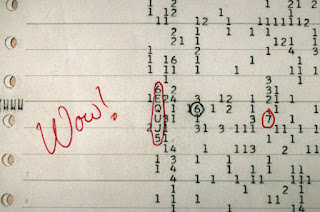Cosmic Microwave Background Radiation
When I was younger, in order to receive and interpret radio wave signals as pictorial and audient information analogue television required tuning in. My grandad tried to explain to me that the static fuzz of black and white pixels was an untuned television trying to interpret the universes oldest radiation. I was too young at the time to understand what he meant. Now I have come to appreciate this as the cosmic microwave background radiation (CMBR):
| The CMBR data interpreted as a universal heat map in the sky |
What it is it? Predicted to exist in the 1940’s and discovered in the 1960’s, the CMBR is currently the oldest existing radiation in our universe, it is everywhere. The radiation waves are millimetres in length and thus relatively long in the electromagnetic spectrum, they cannot be seen to the naked eye. The image you see above was recorded by the Planck telescope and the associated data was released in 2006. Careful analysis was required in order to remove other wavelengths of radiation produced by neighbouring stars and galaxies alike.
How did it form? The early universe was very hot and therefore energetic. When tiny particles such as protons and electrons began forming primordial hydrogen, a high energy light particle would effectively smash into this primordial hydrogen breaking it apart. As it was also very dense this light radiation couldn’t escape and would continue to break apart primordial elements, as a result the universe was opaque. After 380,000 years of expansion the universe became cool and less dense. This meant that primordial elements could form whilst light escaped. The dark age epoch was over, the universe became transparent and this high energy light is now detectable as a CMBR remnant.
What does it tell us? The CMBR image is a measure of heat deviation across all points in space. The expanded universe has now cooled to a temperature of around -270 °C. Areas of green indicate little or no net deviation from this average temperature. Areas of blue and red tell us there are cooler and hotter temperature deviations from this average respectively. These temperature deviations are small at around 1-2 °C. However, they are very significant…
What can we conclude? The CMBR shows us that the universe on average is homogenous and isotropic. This means that matter distribution is generally random and smeared across the entirety of the observable universe. Without these small temperature deviations from the beginning of the universe particles wouldn’t have clustered together and thus produce galactic and stellar entities. As a result, some have used the CMBR as a form of galactic cartography. However, careful analysis has shown that there is a slight imbalance of temperature variation in the CMBR data, with some scientists suggesting that temperature is polarised in a specific direction, and thus ultimately indicates the solar systems direction of travel through the universe.
What will happen to the CMBR? The CMBR is comprised of long wavelength radiation. As the universe continues to expand the CMBR wavelength will also continue to increase. Given our current universe models and the current rate of expansion, this radiation wavelength will eventually expand to the point where it is no longer detectable. This means the universe will eventually become even darker and colder over time.
I for one feel that this is the most profound image in science and physical cosmology. A photograph of a young universe which still exists with us today at the age of 13.8 billion years old.





Comments
Post a Comment